python接口自动化(四十)- logger 日志 - 下(超详解)
简介
按照上一篇的计划,这一篇给小伙伴们讲解一下:(1)多模块使用logging,(2)通过文件配置logging模块,(3)自己封装一个日志(logging)类。可能有的小伙伴在这里会有个疑问一个logging为什么分两篇的篇幅来介绍她呢???那是因为日志是非常重要的,用于记录系统、软件操作事件的记录文件或文件集合,可分为事件日志和消息日志。具有处理历史数据、诊断问题的追踪以及理解系统、软件的活动等重要作用,在开发或者测试软系统过程中出现了问题,我们首先想到的就是她——logging。她可不像泰戈尔说的:“天空没有留下翅膀的痕迹,但我已经飞过”;这个90后的小姑娘,她可是一个爱炫耀,爱显摆的人已经达到了人过留名、雁过留声的境界。好了逗大家一乐,下面开始进入今天的正题。
多模块使用logging
1、父模块fatherModule.py:

2、子模块sonModule.py:
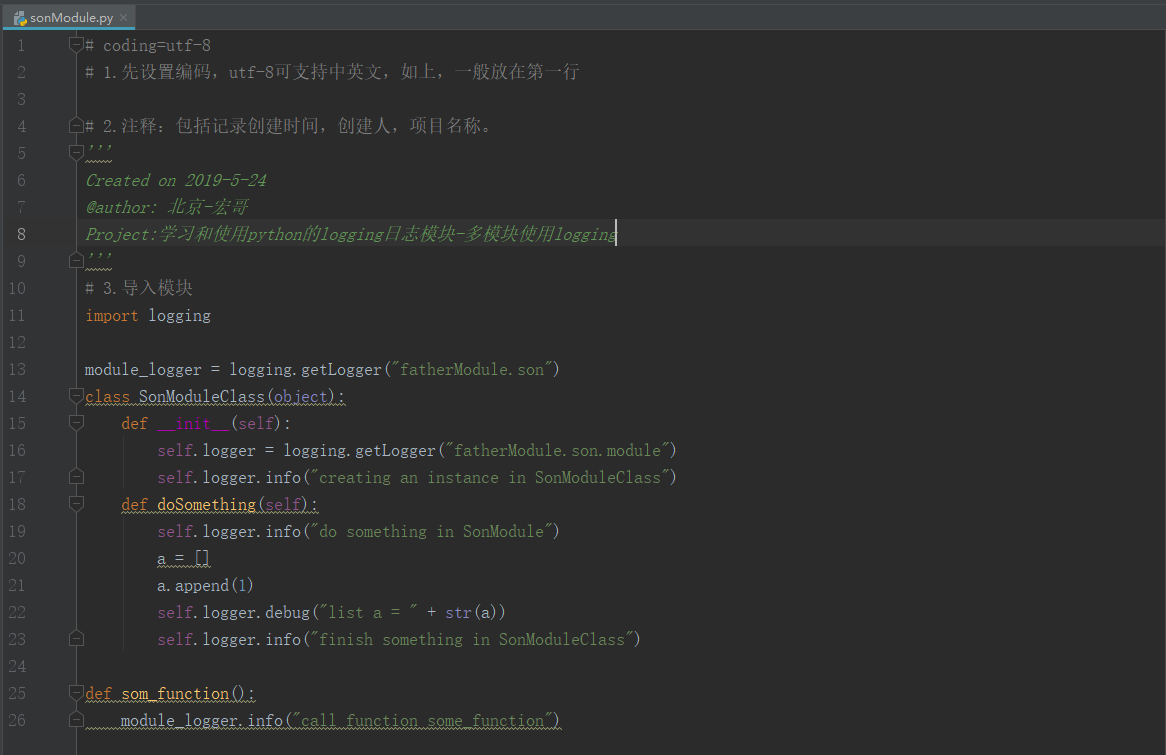
3、运行结果,在控制和日志文件log.txt中输出:
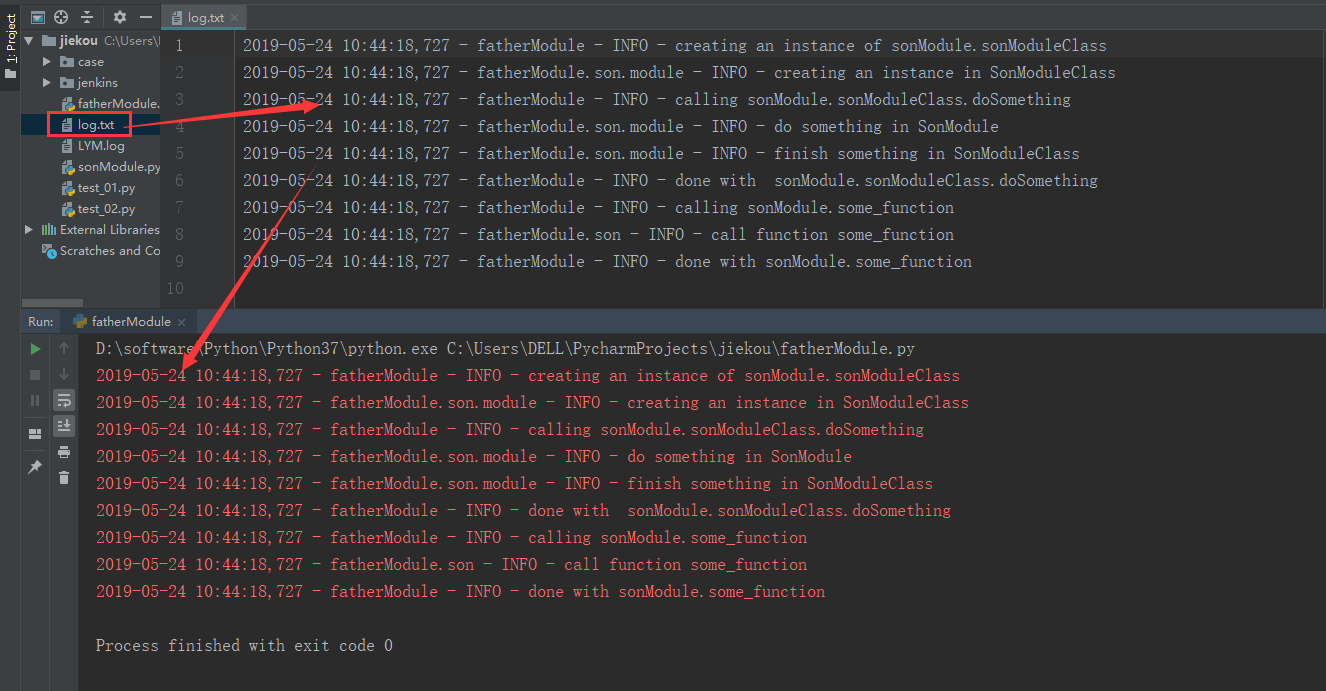
首先在父模块定义了logger'fatherModule',并对它进行了配置,就可以在解释器进程里面的其他地方通过getLogger('fatherModule')得到的对象都是一样的,不需要重新配置,可以直接使用。定义的该logger的子logger,
都可以共享父logger的定义和配置,所谓的父子logger是通过命名来识别,任意以'fatherModule'开头的logger都是它的子logger,例如'fatherModule.son'。
实际开发一个application,首先可以通过logging配置文件编写好这个application所对应的配置,可以生成一个根logger,如'PythonAPP',然后在主函数中通过fileConfig加载logging配置,接着在application的其他地方、不同的模块中,可以使用根logger的子logger,
如'PythonAPP.Core','PythonAPP.Web'来进行log,而不需要反复的定义和配置各个模块的logger。
4、参考代码
fatherModule.py文件:
# coding=utf-
# .先设置编码,utf-8可支持中英文,如上,一般放在第一行 # .注释:包括记录创建时间,创建人,项目名称。
'''
Created on --
@author: 北京-宏哥
Project:学习和使用python的logging日志模块-多模块使用logging
'''
# .导入模块
import logging
import sonModule
logger = logging.getLogger("fatherModule")
logger.setLevel(level = logging.INFO)
handler = logging.FileHandler("log.txt")
handler.setLevel(logging.INFO)
formatter = logging.Formatter('%(asctime)s - %(name)s - %(levelname)s - %(message)s')
handler.setFormatter(formatter) console = logging.StreamHandler()
console.setLevel(logging.INFO)
console.setFormatter(formatter) logger.addHandler(handler)
logger.addHandler(console) logger.info("creating an instance of sonModule.sonModuleClass")
a = sonModule.SonModuleClass()
logger.info("calling sonModule.sonModuleClass.doSomething")
a.doSomething()
logger.info("done with sonModule.sonModuleClass.doSomething")
logger.info("calling sonModule.some_function")
sonModule.som_function()
logger.info("done with sonModule.some_function")
sonModule.py文件:
# coding=utf-
# .先设置编码,utf-8可支持中英文,如上,一般放在第一行 # .注释:包括记录创建时间,创建人,项目名称。
'''
Created on --
@author: 北京-宏哥
Project:学习和使用python的logging日志模块-多模块使用logging
'''
# .导入模块
import logging module_logger = logging.getLogger("fatherModule.son")
class SonModuleClass(object):
def __init__(self):
self.logger = logging.getLogger("fatherModule.son.module")
self.logger.info("creating an instance in SonModuleClass")
def doSomething(self):
self.logger.info("do something in SonModule")
a = []
a.append()
self.logger.debug("list a = " + str(a))
self.logger.info("finish something in SonModuleClass") def som_function():
module_logger.info("call function some_function")
文件配置logging模块
1、通过logging.config模块配置日志构造信息
logger.conf文件:
[loggers]
keys = root, example01, example02
[logger_root]
level = DEBUG
handlers = hand01, hand02
[logger_example01]
handlers = hand01, hand02
qualname = example01
propagate =
[logger_example02]
handlers = hand01, hand03
qualname = example02
propagate =
[handlers]
keys = hand01, hand02, hand03
[handler_hand01]
class = StreamHandler
level = INFO
formatter = form01
args=(sys.stdout, )
[handler_hand02]
class = FileHandler
level = DEBUG
formatter = form01
args = ('log/test_case_log.log', 'a')
[handler_hand03]
class = handlers.RotatingFileHandler
level = INFO
formatter = form01
args = ('log/test_case_log.log', 'a', **,)
[formatters]
keys = form01, form02
[formatter_form01]
format = %(asctime)s-%(filename)s-[line:%(lineno)d]-%(levelname)s-[LogInfoMessage]: %(message)s
datefmt = %a, %d %b %Y %H:%M:%S
[formatter_form02]
format = %(name)-12s: %(levelname)-8s-[日志信息]: %(message)s
datefmt = %a, %d %b %Y %H:%M:%S
一、实例:
1、实例代码
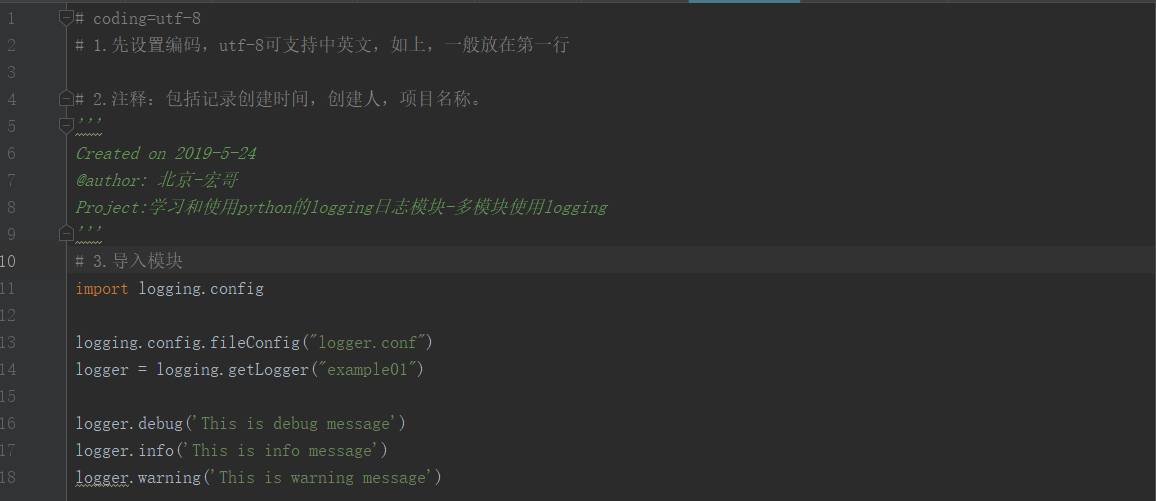
2、运行结果:

3、参考代码:
# coding=utf-
# .先设置编码,utf-8可支持中英文,如上,一般放在第一行 # .注释:包括记录创建时间,创建人,项目名称。
'''
Created on --
@author: 北京-宏哥
Project:学习和使用python的logging日志模块-多模块使用logging
'''
# .导入模块
import logging
import logging.config logging.config.fileConfig("logger.conf")
logger = logging.getLogger("example01") logger.debug('This is debug message')
logger.info('This is info message')
logger.warning('This is warning message')
二、实例
1、实例代码
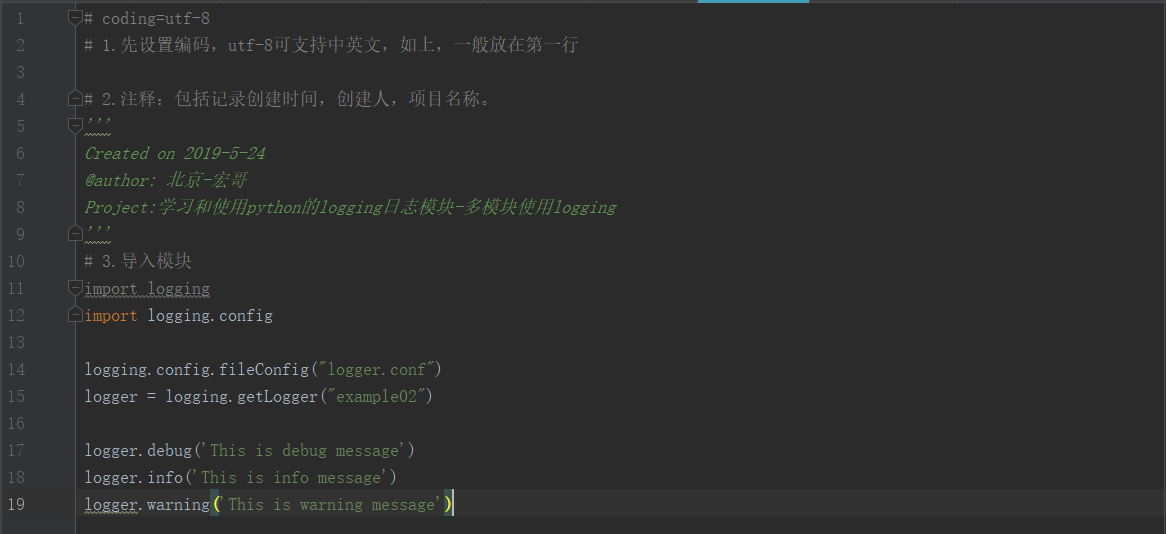
2、运行结果

3、参考代码:
# coding=utf-
# .先设置编码,utf-8可支持中英文,如上,一般放在第一行 # .注释:包括记录创建时间,创建人,项目名称。
'''
Created on --
@author: 北京-宏哥
Project:学习和使用python的logging日志模块-多模块使用logging
'''
# .导入模块
import logging
import logging.config logging.config.fileConfig("logger.conf")
logger = logging.getLogger("example02") logger.debug('This is debug message')
logger.info('This is info message')
logger.warning('This is warning message')
2、通过JSON文件配置
json配置文件:
{
"version":,
"disable_existing_loggers":false,
"formatters":{
"simple":{
"format":"%(asctime)s - %(name)s - %(levelname)s - %(message)s"
}
},
"handlers":{
"console":{
"class":"logging.StreamHandler",
"level":"DEBUG",
"formatter":"simple",
"stream":"ext://sys.stdout"
},
"info_file_handler":{
"class":"logging.handlers.RotatingFileHandler",
"level":"INFO",
"formatter":"simple",
"filename":"info.log",
"maxBytes":"",
"backupCount":,
"encoding":"utf8"
},
"error_file_handler":{
"class":"logging.handlers.RotatingFileHandler",
"level":"ERROR",
"formatter":"simple",
"filename":"errors.log",
"maxBytes":,
"backupCount":,
"encoding":"utf8"
}
},
"loggers":{
"my_module":{
"level":"ERROR",
"handlers":["info_file_handler"],
"propagate":"no"
}
},
"root":{
"level":"INFO",
"handlers":["console","info_file_handler","error_file_handler"]
}
}
1、通过JSON加载配置文件,然后通过logging.dictConfig配置logging:
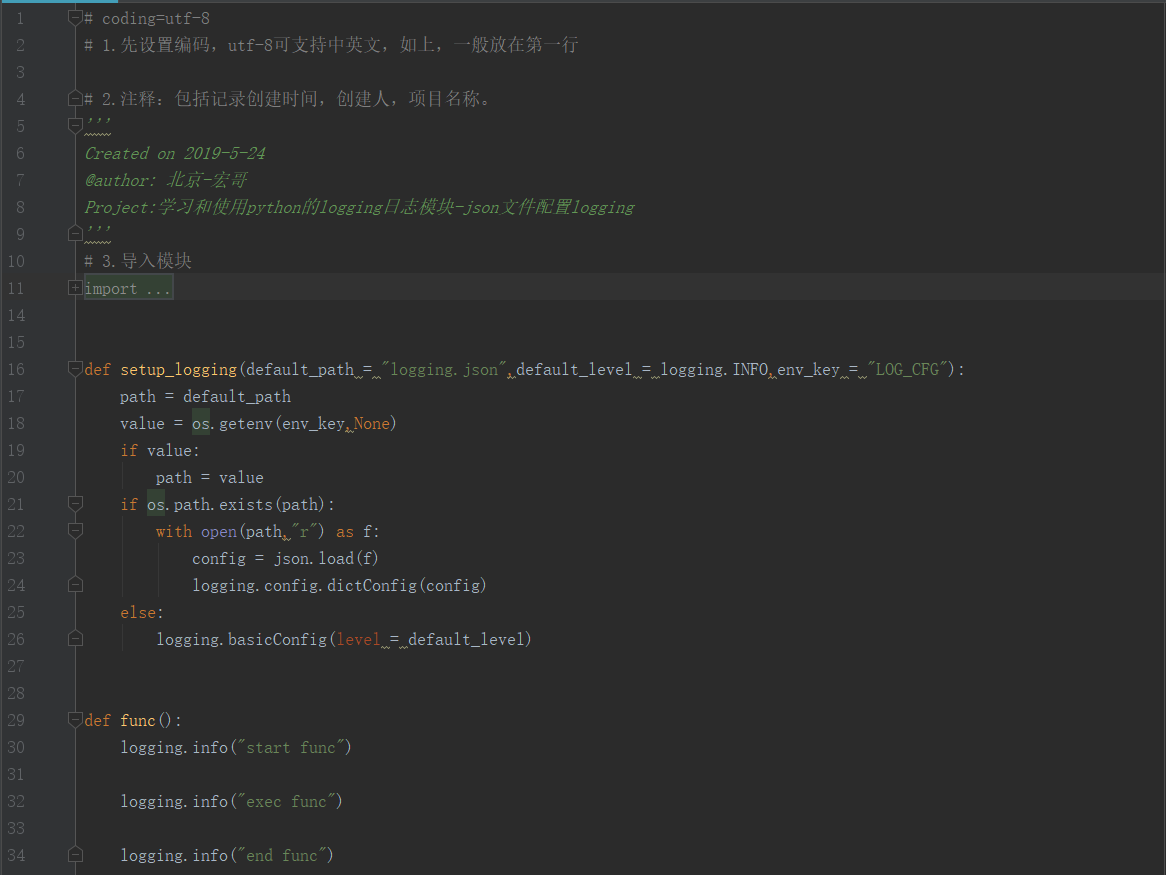
2、运行结果:

3、参考代码:
1 import json
2 import logging.config
3 import os
4
5 def setup_logging(default_path = "logging.json",default_level = logging.INFO,env_key = "LOG_CFG"):
6 path = default_path
7 value = os.getenv(env_key,None)
8 if value:
9 path = value
10 if os.path.exists(path):
11 with open(path,"r") as f:
12 config = json.load(f)
13 logging.config.dictConfig(config)
14 else:
15 logging.basicConfig(level = default_level)
16
17 def func():
18 logging.info("start func")
19
20 logging.info("exec func")
21
22 logging.info("end func")
23
24 if __name__ == "__main__":
25 setup_logging(default_path = "logging.json")
26 func()
3、通过YAML文件配置
1、首先要导入yaml模块,输入命令 python2: pip install yaml python3:pip install pyyaml

2、通过YAML文件进行配置,比JSON看起来更加简介明了:
logging.yaml文件:
version:
disable_existing_loggers: False
formatters:
simple:
format: "%(asctime)s - %(name)s - %(levelname)s - %(message)s"
handlers:
console:
class: logging.StreamHandler
level: DEBUG
formatter: simple
stream: ext://sys.stdout
info_file_handler:
class: logging.handlers.RotatingFileHandler
level: INFO
formatter: simple
filename: info.log
maxBytes:
backupCount:
encoding: utf8
error_file_handler:
class: logging.handlers.RotatingFileHandler
level: ERROR
formatter: simple
filename: errors.log
maxBytes:
backupCount:
encoding: utf8
loggers:
my_module:
level: ERROR
handlers: [info_file_handler]
propagate: no
root:
level: INFO
handlers: [console,info_file_handler,error_file_handler]
3、通过YAML加载配置文件,然后通过logging.dictConfig配置logging:

4、运行结果:

5、参考代码:
# coding=utf-
# .先设置编码,utf-8可支持中英文,如上,一般放在第一行 # .注释:包括记录创建时间,创建人,项目名称。
'''
Created on --
@author: 北京-宏哥
Project:学习和使用python的logging日志模块-yaml文件配置logging
'''
# .导入模块
import yaml
import logging.config
import os def setup_logging(default_path = "logging.yaml",default_level = logging.INFO,env_key = "LOG_CFG"):
path = default_path
value = os.getenv(env_key,None)
if value:
path = value
if os.path.exists(path):
with open(path,"r") as f:
config = yaml.load(f)
logging.config.dictConfig(config)
else:
logging.basicConfig(level = default_level) def func():
logging.info("start func") logging.info("exec func") logging.info("end func") if __name__ == "__main__":
setup_logging(default_path = "logging.yaml")
func()
注意:配置文件中“disable_existing_loggers” 参数设置为 False;如果不设置为False,创建了 logger,然后你又在加载日志配置文件之前就导入了模块。logging.fileConfig 与 logging.dictConfig 默认情况下会使得已经存在的 logger 失效。那么,这些配置信息就不会应用到你的 Logger 上。“disable_existing_loggers” = False解决了这个问题
自己封装一个logging类
1、实例代码:
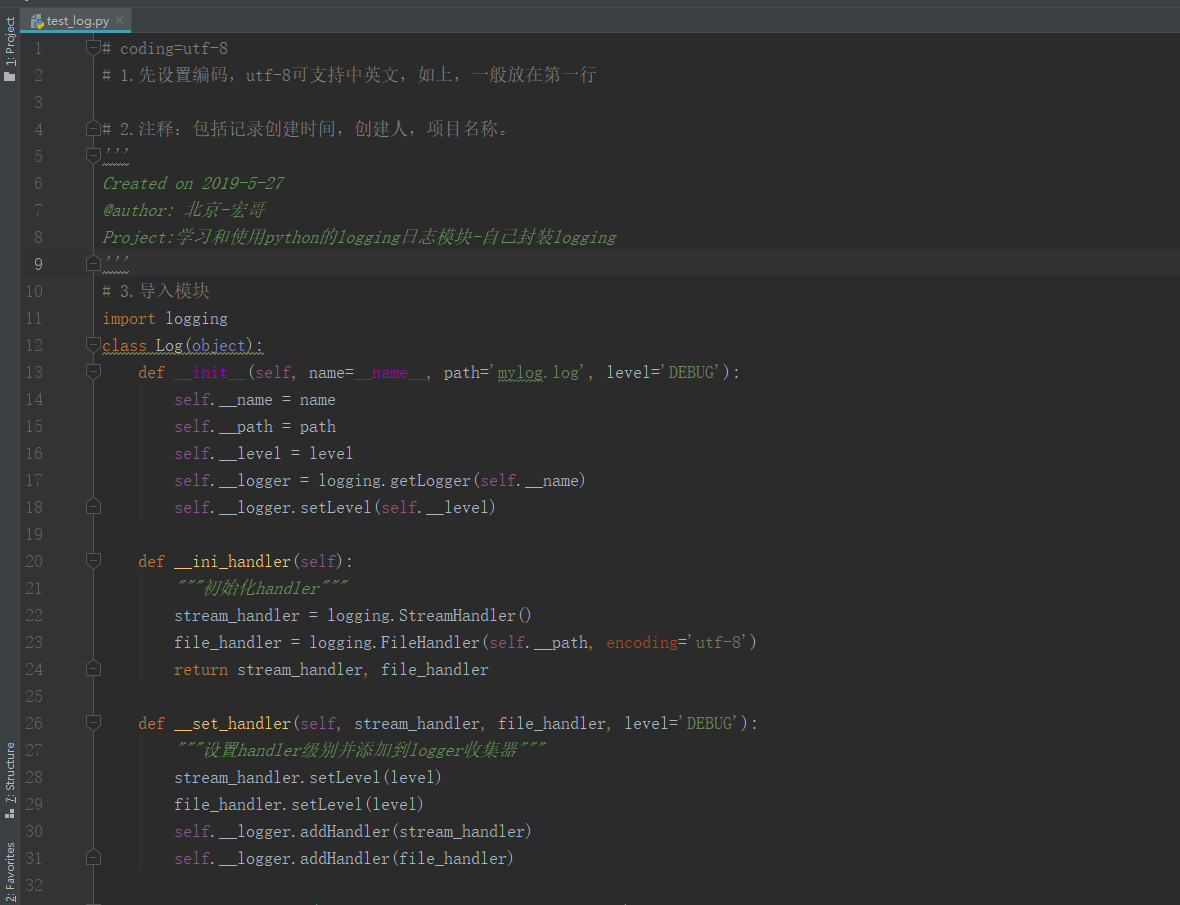
2、运行结果:

3、参考代码:
# coding=utf-
# .先设置编码,utf-8可支持中英文,如上,一般放在第一行 # .注释:包括记录创建时间,创建人,项目名称。
'''
Created on --
@author: 北京-宏哥
Project:学习和使用python的logging日志模块-自己封装logging
'''
# .导入模块
import logging
class Log(object):
def __init__(self, name=__name__, path='mylog.log', level='DEBUG'):
self.__name = name
self.__path = path
self.__level = level
self.__logger = logging.getLogger(self.__name)
self.__logger.setLevel(self.__level) def __ini_handler(self):
"""初始化handler"""
stream_handler = logging.StreamHandler()
file_handler = logging.FileHandler(self.__path, encoding='utf-8')
return stream_handler, file_handler def __set_handler(self, stream_handler, file_handler, level='DEBUG'):
"""设置handler级别并添加到logger收集器"""
stream_handler.setLevel(level)
file_handler.setLevel(level)
self.__logger.addHandler(stream_handler)
self.__logger.addHandler(file_handler) def __set_formatter(self, stream_handler, file_handler):
"""设置日志输出格式"""
formatter = logging.Formatter('%(asctime)s-%(name)s-%(filename)s-[line:%(lineno)d]'
'-%(levelname)s-[日志信息]: %(message)s',
datefmt='%a, %d %b %Y %H:%M:%S')
stream_handler.setFormatter(formatter)
file_handler.setFormatter(formatter) def __close_handler(self, stream_handler, file_handler):
"""关闭handler"""
stream_handler.close()
file_handler.close() @property
def Logger(self):
"""构造收集器,返回looger"""
stream_handler, file_handler = self.__ini_handler()
self.__set_handler(stream_handler, file_handler)
self.__set_formatter(stream_handler, file_handler)
self.__close_handler(stream_handler, file_handler)
return self.__logger if __name__ == '__main__':
log = Log(__name__, 'file.log')
logger = log.Logger
logger.debug('I am a debug message')
logger.info('I am a info message')
logger.warning('I am a warning message')
logger.error('I am a error message')
logger.critical('I am a critical message')
小结
1、在yaml文件配置logging的时候,会有个报警信息。有代码洁癖的人,可以处理一下

2、是什么原因造成上面的告警呢???是因为:YAML 5.1版本后弃用了yaml.load(file)这个用法,因为觉得很不安全,5.1版本之后就修改了需要指定Loader,通过默认加载器(FullLoader)禁止执行任意函数,该load函数也变得更加安全。
3、解决办法:
不用改很多代码 加一句就行了 在yaml.load(f, Loader=yaml.FullLoader) 加上 Loader=yaml.FullLoader 就行了。这里要注意的是L要大写的,否则会报错的。
4、加上以后,看一下运行结果:
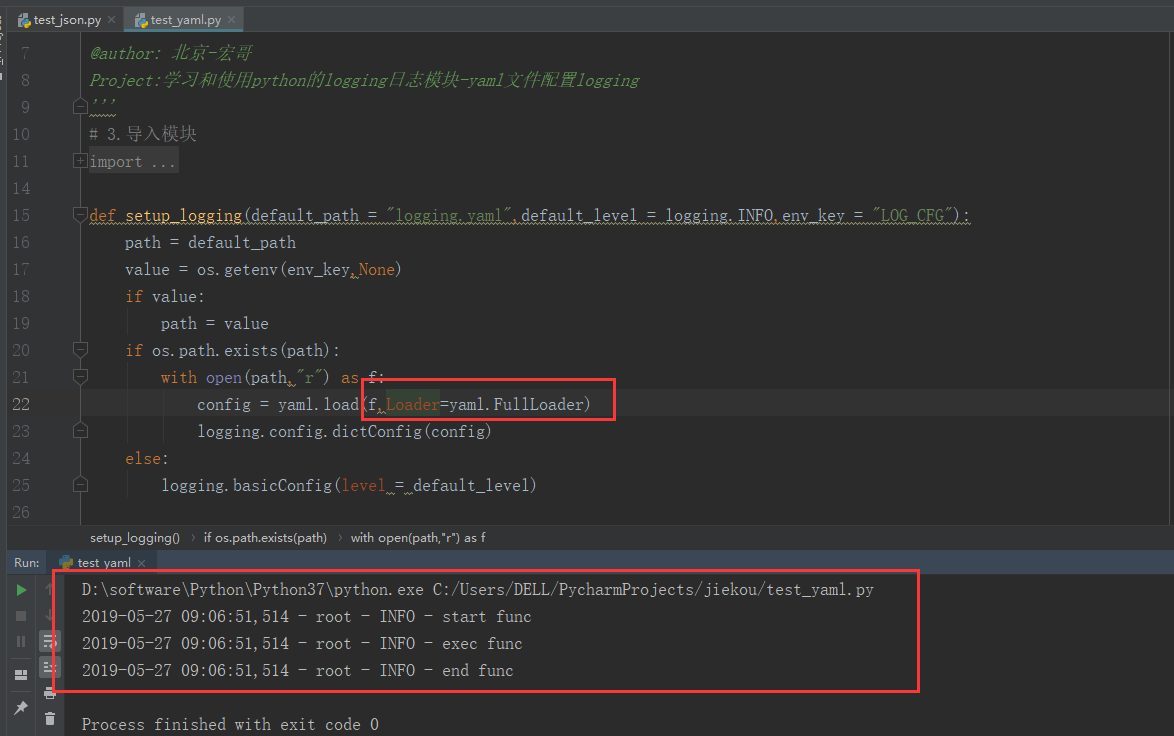
最后给大家留个彩蛋:文章中有一处bug,会影响运行结果而报错,聪明的你,可以找到吗???嘿嘿!!!欢迎互动和留言
python接口自动化(四十)- logger 日志 - 下(超详解)的更多相关文章
- python接口自动化(十)--post请求四种传送正文方式(详解)
简介 post请求我在python接口自动化(八)--发送post请求的接口(详解)已经讲过一部分了,主要是发送一些较长的数据,还有就是数据比较安全等.我们要知道post请求四种传送正文方式首先需要先 ...
- java接口自动化(一) - 接口自动化测试整体认知 - 开山篇(超详解)
简介 了解什么是接口和为什么要做接口测试.并且知道接口自动化测试应该学习哪些技术以及接口自动化测试的落地过程.其实这些基本上在python接口自动化的文章中已经详细的介绍过了,不清楚的可以过去看看.了 ...
- python接口自动化(十四)--session关联接口(详解)
简介 上一篇cookie绕过验证码模拟登录博客园,但这只是第一步,一般登录后,还会有其它的操作,如发帖,评论等等,这时候如何保持会话呢?这里我以jenkins平台为例,给小伙伴们在沙场演练一下. se ...
- python接口自动化四(json数据处理)
前言 有些post的请求参数是json格式的,这个前面第二篇post请求里面提到过,需要导入json模块处理. 一般常见的接口返回数据也是json格式的,我们在做判断时候,往往只需要提取其中几个关键的 ...
- python接口自动化(十六)--参数关联接口后传(详解)
简介 大家对前边的自动化新建任务之后,接着对这个新建任务操作了解之后,希望带小伙伴进一步巩固胜利的果实,夯实基础.因此再在沙场实例演练一下博客园的相关接口.我们用自动化发随笔之后,要想接着对这篇随笔操 ...
- python接口自动化(十八)--重定向(Location)(详解)
简介 在实际工作中,有些接口请求完以后会重定向到别的url,而你却需要重定向前的url.URL主要是针对虚拟空间而言,因为不是自己独立管理的服务器,所以无法正常进行常规的操作.但是自己又不希望通过主域 ...
- python接口自动化(十五)--参数关联接口(详解)
简介 我们用自动化新建任务之后,要想接着对这个新建任务操作,那就需要用参数关联了,新建任务之后会有一个任务的Jenkins-Crumb,获取到这个Jenkins-Crumb,就可以通过传这个任务Jen ...
- Appium+python自动化(二十)- 猴哥失散多年的混血弟弟还是妹妹- Monkey(猴子)日志(超详解)
简介 日志是非常重要的,用于记录系统.软件操作事件的记录文件或文件集合,可分为事件日志和消息日志.具有处理历史数据.诊断问题的追踪以及理解系统.软件的活动等重要作用,在开发或者测试软系统过程中出现了问 ...
- python接口自动化(十九)--Json 数据处理---实战(详解)
简介 上一篇说了关于json数据处理,是为了断言方便,这篇就带各位小伙伴实战一下.首先捋一下思路,然后根据思路一步一步的去实现和实战,不要一开始就盲目的动手和无头苍蝇一样到处乱撞,撞得头破血流后而放弃 ...
- python接口自动化(十二)--https请求(SSL)(详解)
简介 本来最新的requests库V2.13.0是支持https请求的,但是一般写脚本时候,我们会用抓包工具fiddler,这时候会 报:requests.exceptions.SSLError: [ ...
随机推荐
- Python虚拟机类机制之从class对象到instance对象(五)
从class对象到instance对象 现在,我们来看看如何通过class对象,创建instance对象 demo1.py class A(object): name = "Python&q ...
- python如何合并两个字典
我有两个Python字典,如何合并它们呢?update()方法正是你所需要的. >>> x = {'a':1, 'b': 2} >>> y = {'b':10, ' ...
- Windows网络编程笔记6 --- WinSock I/O 控制方法
Windows提供了两种方式“套接字模式”和“套接字I/O模型”,可对一个套接字上的I/O行为加以控制.套接字模式用于决定在随一个套接字调用时,那些 Winsock函数的行为.其中的模型包括括sele ...
- PostgreSQL 行排序详解
在查询生成输出表之后,也就是在处理完选择列表之后,你还可以对输出表进行排序. 如果没有排序,那么行将以不可预测的顺序返回(实际顺序将取决于扫描和连接规划类型和在磁盘上的顺序, 但是肯定不能依赖这些东西 ...
- 【转】log4js在PM2的cluster模式下大坑
请直接查看原文:https://blog.yourtion.com/fix-log4js-with-pm2-not-work.html 之前一直使用 debug 还有 console.log 去打日志 ...
- 2015年iOS开发总结
从我开始接触iOS到现在已经有一年的时间了,刚好年末总结一下. 我是去年11月份培训的,在培训公司苦逼的学习了4个月之后,找到了第一家公司,是个外包公司,在里面还是学到了很多东西,产品的需求,设计,框 ...
- 习题:八数码难题(双向BFS)
八数码难题(wikioi1225) [题目描述] 在3×3的棋盘上,摆有八个棋子,每个棋子上标有1至8的某一数字.棋盘中留有一个空格,空格用0来表示.空格周围的棋子可以移到空格中.要求解的问题是:给出 ...
- try 与catch的作用
首先要清楚,如果没有try的话,出现异常会导致程序崩溃.而try则可以保证程序的正常运行下去,比如说: try{ int i = 1/0; }catch(Exception e){ e.printSt ...
- linux系统——网络调试工具
http://blog.csdn.net/chinalinuxzend/article/details/1799279 1.网络调试工具概说: 如 果我们把一台机器接入网络中,通过网络配置工具的配置这 ...
- Java EE 学习:使用 idea2017 搭建 SSM 框架
需要准备的环境: idea 2017.1 jdk1.8 Maven 3.3.9 请提前将idea与Maven.jdk配置好,本次项目用的都是比较新的 步骤: 一.首先使用idea新建一个Maven w ...
